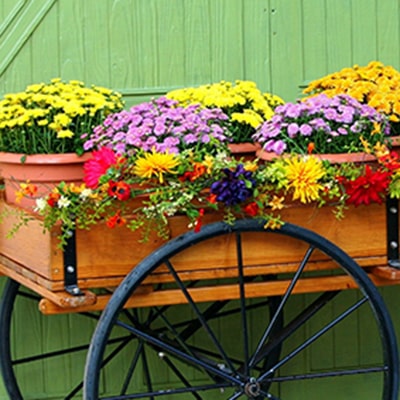
Just because summer has fizzled out doesn’t mean you can pack everything away and hibernate. Leave that for the bears in the woods.
Clean down and plant up your containers for instant colour and continued interest until 2020 brings whatever 2020 fancies. Read on to find out all you need to know about autumn container gardening.
For Fantastic Autumn Containers
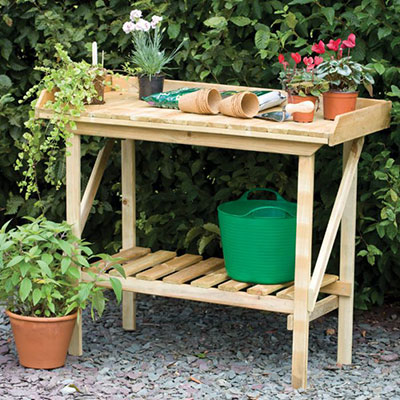
Clean Up Containers
It’s important to clear out any dead or fading summer bedding plants before planting up.
These can be simply ripped out and composted or cut hard back, re-potted into individual pots and overwintered in a frost-free greenhouse.
Fuchsias are a great example of a plant you can cut back and grow on for next spring.
Lobelia, however, is best jettisoned and fed to the voracious compost heap.
Once containers are clean, give them a good wash with soapy water and allow them to dry.
This removes any lingering spores of rot and diseases, whose sole aim in life is to spoil your new displays (not actually true as they do help decay plant material and that is important - but you get the sentiment).
Basic Tip for Clean Containers
Clean containers are great, but there is one last thing to bear in mind before planting starts - ensure all drainage holes are clear of debris.
(Obviously they will be because you’ve washed them in soapy water and have done a great job!)

Size of Containers
Does Size Matter?
The size of container depends on the type of plant you want to grow.
In theory, and many large nurseries prove it in practice, anything can be grown in a container.
Large trees are often supplied in containers of around a metre cubed, whereas a small window box is equally capable of providing home to smaller specimens.
Read about the plants you have, or want, and match up the container size appropriately.

Container Material
The material that containers are constructed from is relatively unimportant to a plant - simply choose what you like and what goes well in your garden.
Terracotta and wooden containers and planters always look traditional and match most gardens. Galvanised metal is a current trend and looks terrific in modern gardens and balcony gardens. Concrete and plastic containers are good all-rounders.
Basic Tip with Terracotta Containers
If planting up a terracotta pot, check if it is frost proof.
A quick tip is if you can see a line down the pot (a manufacturing line), chances are the pot is machine made and may not be frost proof.
Hand-thrown pots do not have such a line and therefore do not have a weak spot.
Just a thought!

Compost in Containers
Can you use the old compost in containers to grow new plants?
No!
The compost is exhausted after sustaining all that summer growth and, with all the water you’ve applied, the air gaps or structure will have degraded.
By all means put the old compost, usually a solid mass of fibrous roots, onto beds and borders.
Break up big lumps with a spade and let nature do the rest.
And then crack open a new bag of compost.
Type of Compost
Multi-purpose compost is best for most containers but it’s preferable to use a loam-based compost mix for larger containers.
That is because large containers support larger plants, which in turn are heavier.
This could result in the container blowing over, unless a heavier loam-based compost is used.
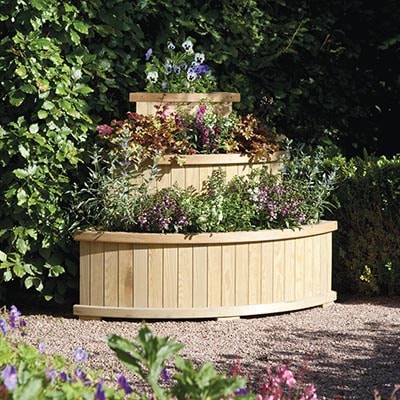
Crocks or Not?
There is quite a debate about whether the perceived wisdom of adding a layer of crocks actually does what we all thought they should do, i.e. improve drainage.
Some say they don’t, with evidence, while others say they do, with equally compelling evidence.
The horticultural jury is still out - but surely crocks help keep compost from blocking or even flowing through the drainage holes and making a right old mess on your patio?
Try two pots, one with crocks and one without, to see if there’s any difference for yourself.

Water Containers Well
Containers need water, especially when crammed with plants.
The leaves stop natural rainwater reaching the compost and then, of course, there is the mass of roots sucking the compost dry.
Even in autumn and winter, check how dry the compost is and water as necessary.
Stored rainwater from water butts is always preferable to tap water. Rigging up a couple of water butts is always a good idea in autumn because a day or so of rain onto a shed roof will soon fill them up.
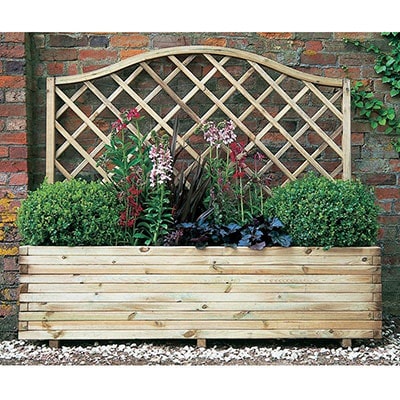
Check Containers Daily
Just like in summer, it’s a good idea to check your containers on a daily basis.
In warmer autumns and winters, bugs such as laphids can get a sneaky hold and need to be sorted ASAP.
Same goes for diseases - nip off any flowers and leaves that begin to fade to reduce the incidence of rots.
More Basic Tips for Autumn Containers

Raise Them Off the Ground
Raise all of your containers off the ground to ensure water flows freely from underneath the bases.
This stops the container sitting in a puddle, where water is continually soaking back into the compost.
This could lead to root rot.
Pot feet are readily available but half bricks do the same job.

Move Them Around
Move your containers around as they come into peak performance and fade.
Large containers can be placed on wheeled platforms to ease their movement.
Plant Bulbs
In autumn, plant bulbs into the compost around your container plants at planting time.
It’s easy to pop a few dwarf tulips or daffs in the compost and you will be delighted when they push up through the compost and flower in early spring.
It adds interest to your winter containers.
The Best Container Plants for Autumn
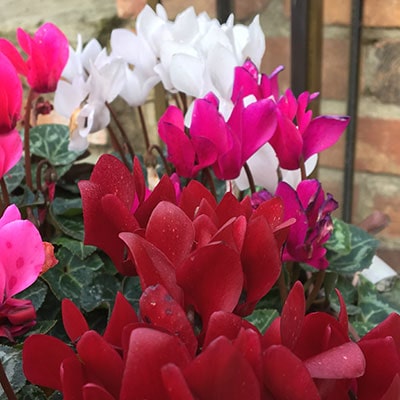
Cyclamen
Cyclamen are super little plants and perfect for all containers.
Small pots can be crammed with them for a lovely display.
Larger containers can be underplanted with them - another super display. Underplanted is where you plant your main specimen in the middle and then plant smaller plants all around the base.
All you need to do is to pull the old flowers off as they fade. Do this regularly to ensure weeks of blooms. And that's blooms from autumn, throughout winter and into early spring.

Rudbeckia
Rudbeckia are superb plants for fantastic autumn blooms and easy to grow in a medium-sized container.
Look for a variety called ‘Toto Lemon’ for lovely daisy-like blooms in autumn.
And once you’ve had enough of the plants in your containers, you can plant them out in your herbaceous borders.

Another cracker variety of Rudbeckia is called ‘Patio Brown Improved’.
Perhaps not imaginatively named, but the deep russet blooms with chocolate button centres are gorgeous in containers.

Chrysanthemums
Chrysanthemums are a fantastic flowering plant. perfect for containers.
They are available in a variety of colours and grow well in containers, window boxes, and look sensational in hanging baskets.
Hard frosts will knock them back so, if a prolonged period of freezing weather is forecast, try and protect by covering overnight in fleece, or even taking the whole container into a cool place for a day or two.
Nip off dead flower heads to prolong flowering.

Heathers
Heathers are tough little plants, available in a range of colours, and grow well in containers. They add colour and interest from autumn through to spring.
Choose an ericaceous or acidic compost for best results.
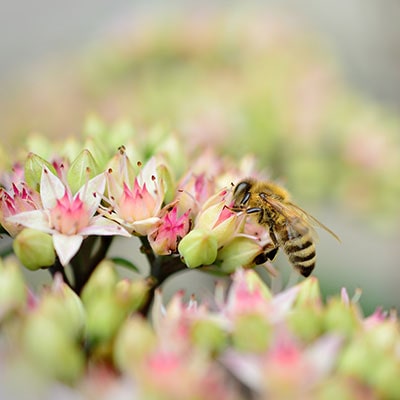
Sedums
Sedums are lovely plants and can add a touch of the exotic to any autumn or winter garden.
Succulent by nature, they need a well-drained compost so add grit to the compost and clear any drainage holes.
Cold, wet weather can cause a few problems so, if it is particularly wet, tip the pots by slightly propping them up with a stone or wedge of wood. This will ensure water moves away from the crowns of plants.
If we get deep freeze weather, play safe and take sedum pots into a cold greenhouse or porchway.

Other Ideas
Ornamental grasses are well suited to pots and, even when everything slows down and stops for winter, the drying flowerheads look superb.
Winter flowering pansies are unbeatable for flower-for-money, and ornamental cabbage adds outrageous colour to any container.
Combine grasses and these autumn flowering bedding plants for the best containers you will ever grow.
Plant Containers for Sale
You’ve heard from the expert gardener. Now it’s time to choose some of Shedstore’s superb garden planters and to put Phil’s advice into action.





